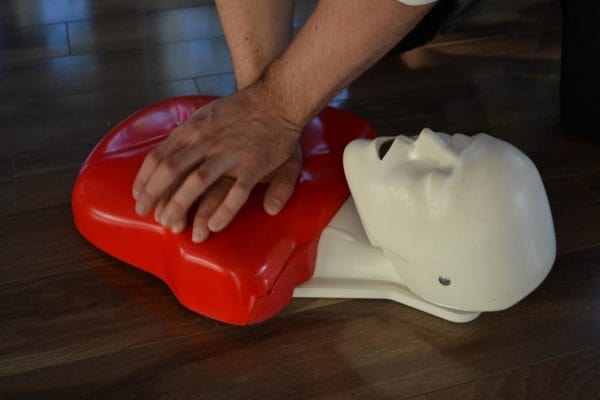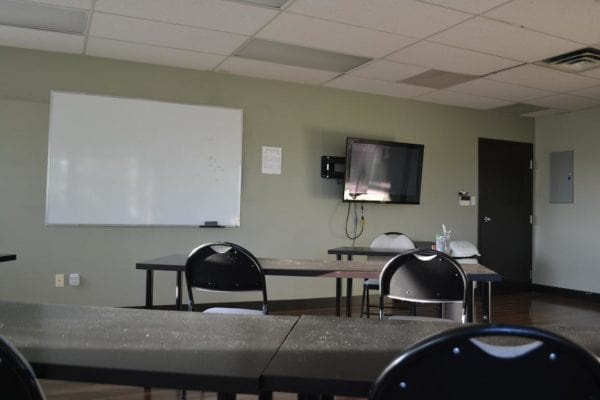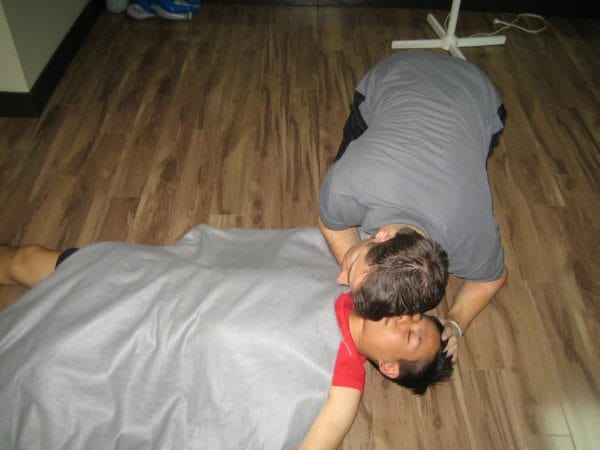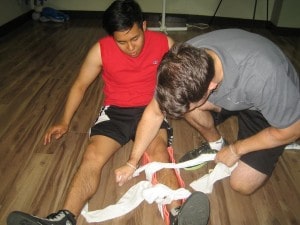CPR Only Training
Are you looking to learn only CPR techniques and don’t want any training in first aid? St Mark James Training offers cardiopulmonary resuscitation (CPR) and automated external defibrillator (AED) programs for individuals needing only CPR and AED training. This programs meet CPR standards for workplace and academic requirements. Candidates that complete these half / full day programs receive a CPR certificate that is valid throughout Canada for 3 years. Learn more by selecting one of the options below.

Register for a Course
We offer a range of different training programs to help you get prepared for a number of emergencies. All of our training providers offer extremely competitive prices and offer amazing teaching facilities and teachers. Candidates will receive training manuals and awards upon completion of the course. Register today to learn the skills to save a life.

First Aid Training
Would you know what to do in a serious emergency? Would you be able to help someone if they were hurt, suffering a heart attack or suddenly fell unconscious? Canadian first aid and CPR training teaches effective and easy to learn techniques to individuals that want to learn to help. Two major first aid courses are available for Canadians that want to learn the basics in helping others. Standard first aid is a two day course that meets a number of workplace, academic and government certification standards. Emergency First Aid is a comprehensive one day course that also meets the same certification standards. Both classes include training in cardiopulmonary resuscitation (CPR) and the effective use of automated external defibrillators (AED).

St Mark James, Vancouver First Aid Ltd, Heart and Stroke Foundation and St. Johns Ambulance collectively updated their program in 2011. The CPR and first aid changes were the most significant changes that have occurred within the past decade. Different providers changed their standards at different times throughout 2011. Standards in all level’s of CPR changed and in both Standard First Aid and Emergency First Aid. To learn about all the latest first aid and CPR techniques take a hands-on course through one our partnered and credible workplace approved first aid providers. All of our partnered providers are listed on our first aid and CPR location page.
CPR Changes

Cardiopulmonary Resuscitation (CPR) has, since the 1970’s, been as easy as A-B-C. However, that standard changed in 2011. CPR courses no longer follow the acronym A-B-C, which stands for airway, breathing and circulation, but instead follow a system of C-A-B. The definitions for all letters in the acronym have stayed the same. More emphasis has been put on chest compression’s. The earlier a rescuer performs chest compression’s the higher the percentage chance of recovery. The other major change to CPR that occurred in 2011 is that rescuers send a bystander to contact EMS after they have checked for breathing to relay the information to the EMS. Other minor changes to CPR have also been implemented into CPR level “A”, CPR level “C” and Health Care Provider CPR. In order to learn all the new CPR changes and to practice these skills take a first aid and CPR course.
CPR / Choking Procedure Changes
The procedures to rescue choking victims have also been changed in the new 2011 standards. Rather than just providing “J-Thrusts” to fully obstructed conscious victims, rescuers will alternate between 5 “J-Thrusts” and 5 back blows. This method of rescue had already been part of the choking rescue procedures prior to 2001, however, was removed for the past decade. The providers, backed by recommendations from the International Liaison Committee on Resuscitation (ILCOR), have re-introduced this procedure. The recommendations were brought in because statistics have shown a higher percent chance of rescue for rescuers using the back blows and “J-Thrusts”.
First Aid Program Changes
Emergency First Aid
Emergency First Aid has undergone the most drastic changes out of all the first aid and CPR courses. The course has come to include more material from the standard first aid course including more emphasis on the treatment of wounds and bleeding. Candidates will learn how to cater to a wider variety of different wounds involving deadly bleeding, amputations and other serious first aid bleeding situations.
Standard First Aid
The first aid portion of the standard first aid program has remained almost entirely intact. However, the wound portion of the course will adopt the same changes the emergency first aid curriculum has included. With standard first aid being so comprehensive it would be difficult to add any more additional material without extending the length of the course. To learn more about the changes to standard first aid or emergency first aid take a course with your local St Mark James training Provider.
As statistics and information continues to be collected and analyzed, CPR and first aid will continue to adopt changes to provide the most effective procedures and programs to rescue victims. All the major providers including St Mark James Training, Heart and Stroke Foundation and St. Johns Ambulance will change almost in unison to provide the most effective guidelines and standards for CPR and first aid rescues.
Candidates will learn about he latest techniques and guidelines in CPR as presented in this video. This video shows the latest 2012 ILCOR standards on CPR and resuscitation techniques for adult victims using an available pocket mask. All of our training providers advertised from our locations page will teach participants these techniques.
